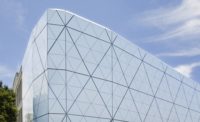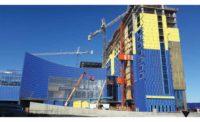The year 2020 may well be remembered as a year of extremes. From a historic hurricane and wildfire season to unprecedented social distancing efforts in commercial buildings, extreme conditions pose challenges when it comes to designing resilient, high-performing commercial enclosures—particularly commercial rooftops.
While extraordinary weather events present challenges for the building enclosure, a shift toward reducing carbon in the atmosphere is also affecting the building materials used in commercial roofs. New regulations going into effect on January 1, 2021 in several U.S. states and Canada, are mandating more sustainable building materials. Meanwhile, building owners and facility executives are seeking material solutions that support access to nature and outdoor air, protect critical assets and help achieve points toward transparency certifications while going beyond meeting baseline codes.
This article considers how extreme weather conditions and stringent code requirements are demanding more resilient rooftops, as new regulations are affecting commercial buildings in a growing number of U.S. states and Canada. We will also consider how building science is offering options to support smart, environmentally responsible buildings without compromising material performance.
Extreme Weather Events Demand Mitigation and Adaptation
Extreme weather events became almost mainstream in 2020. Hurricane Sally made landfall near Gulf Shores, Alabama as a Category 2 storm on September 15, bringing up to 30 inches of rainfall to parts of the Southern U.S. Just one week later, Tropical Storm Beta brought extensive flooding to the Houston area.
As rains ravaged coastal areas, historic wildfires triggered by dry lightning posed a challenge for protecting the wildland urban interface (WUI) in the West. And on August 10-11, a Midwest derecho brought widespread powerful winds to several Midwestern states and portions of southwestern Ontario. Extreme weather left virtually no part of North America unscathed.
How can the AEC community respond to increasing instances of extreme weather? Addressing the challenges posed by rain, fire and wind requires a strategy of adaptation and mitigation.
Vegetative Roofs—Versatility and Performance in the Extreme
From a mitigation perspective, vegetative roof assemblies (VRAs) and plaza decks are an effective strategy to help manage stormwater runoff while providing green spaces in urban environments. Utilizing a layered “sandwich” approach that leverages the moisture management properties of extruded polystyrene insulation (XPS), a waterproofing membrane, growing media, drainage composites and pavers in conjunction with strategically positioned drains, high-performing commercial roofs can retain rainwater and manage stormwater runoff. These assemblies also provide green space that helps reduce the heat island effect on roofs, potentially absorbing carbon emissions in the atmosphere. These spaces may also bring additional benefits to real estate by providing building occupants with usable rooftop square footage for enjoying fresh air and nature.
A few examples of high performing VRAs in urban areas are the Dickies Arena plaza deck in Fort Worth, Texas and the District Wharf mixed-use, riverfront community in Washington, D.C. The Dickies Arena plaza deck delivers compressive strength to support concert performances, vehicle traffic and rooftop gatherings while serving as home to the iconic Fort Worth Stock Show and Rodeo. Spanning nearly a mile of riverfront, the District Wharf creates a community of green roofs and plaza decks offering unique vantage points for taking in some of America’s most beloved landmarks while complying with strict codes for rainwater management. Regulated development projects in the District are required to install practices that retain runoff from a 1.2-inch storm event typically through green infrastructure and capture/reuse systems employing cisterns.
Episodic Extremes
In addition to intense storms that present rainwater runoff challenges, episodic wildfires also pose threats to the enclosure. For example, recent wildfires in the West are driving conversations about code and solutions to help manage risk. An article in the September 12, 2020 issue of The Economist noted, “Fire-risk maps and zoning, which determine who must follow building codes, are in desperate need of a rethink. Among other things, they consider urbanized areas as ‘unburnable,’ which ignores science showing that the majority of buildings catch fire when flying embers are blown a mile or more away from the flaming vegetation.” One off-the-shelf innovation available now to address risks in the WUI, is a continuous insulation system using mineral wool’s fire-resistant properties to support fire hardening for structures in WUI areas.
Extreme Protection for Mission Critical Environments
Of course, the concept of extreme also applies to the value of people, products and processes that commercial roofs protect. The cost of a leak in some buildings can go beyond extreme. For example, a report by the Ponemon Institute estimates the cost of a data center outage at $9,000 per minute. While a building can be replaced, precious treasures inside may be irreplaceable. A lightning strike on the Moody Music Building at the University of Alabama, ignited the roof insulation causing a fire lasting more than 12 hours and requiring more than 1 million gallons of water to extinguish. The building required a complete renovation with no back-up in the interim.
Inspired by the extreme nature of mission critical buildings, cellular glass insulation is both non-combustible and fire-resistant, while delivering compressive strength, redundancy, dimensional stability and resilience to the enclosure. Cellular glass insulation has long been used in some of Europe’s most iconic structures including the Acropolis Museum in Athens and the Swiss National Museum in Zurich. Here in the U.S., cellular glass has proven performance in the extreme, such as the James W. Jardine Water Purification Plant in Chicago, Ill., which has withstood Chicago’s famous lakeshore environment for nearly a half-century.
Steeper Sustainability Requirements
The sustainability conversation is evolving from the energy efficiency focus, which has defined “green building” for the past 15-20 years. While energy efficiency remains very important in today’s sustainability conversation, the focus is shifting toward two key trends: embodied carbon and a circular economy. This migration considers how material systems affect building enclosures; particularly opportunities to reduce the embodied carbon in a building and recycle or repurpose materials so that they are used even after the building has served its purpose.
Effective January 1, 2021, a growing number of states and Canada are eliminating use of high-Global Warming Potential (GWP) hydrofluorocarbon (HFC) blowing agents. New regulations inspired Owens Corning to create a blowing agent that transcends code compliance. The new FOAMULAR NGX (Next Generation Extruded) insulation contains a proprietary blowing agent used to create the cells in insulation polymers and offers a dramatic reduction in the greenhouse gases associated with blowing agents while still delivering the material performance required for VRAs. The blowing agent’s formulation and production process meet or exceed new, more stringent U.S. and Canadian regulatory standards. The FOAMULAR NGX blend dramatically lowers GWP levels in the blowing agent. Finally, transparency documentation provided via environmental product declarations (EPDs), health product declarations (HPDs) and life cycle assessments (LCAs) completed by third party certification bodies provides building owners with assurance of a building’s sustainability profile.
Recognizing that the scientific understanding continues to be developed regarding the impact of human activity on global climate change, Owens Corning believes that key conclusions have earned widespread support requiring the reduction of greenhouse gas emissions (GHG) around the world. Reducing the use of high-Global Warming Potential HFC blowing agents, is one way to aggressively address climate change across our world. Quite simply, the choice of materials matters when it comes to protecting our planet.
An Extreme Future
Looking ahead to 2021, many scientists predict climate change will be an ongoing environmental issue. There is a challenge to leverage this time in history to make sense of events and collaborate on ways to improve. For example, the increased use of videoconferencing may help reduce carbon generated by travel.
Lowering the environmental footprint of commercial buildings will require collaboration across the AEC community as well as cooperation among code officials and building owners. Codes provide a benchmark—but they are a minimum standard of care, the least you can do under the law and not a set of best practices. Research and innovation drive improvement. And a response of adapting and mitigating can help address today’s environmental stressors. As a new year gets underway, a top-down approach to reducing a building’s footprint can start at the roof.





